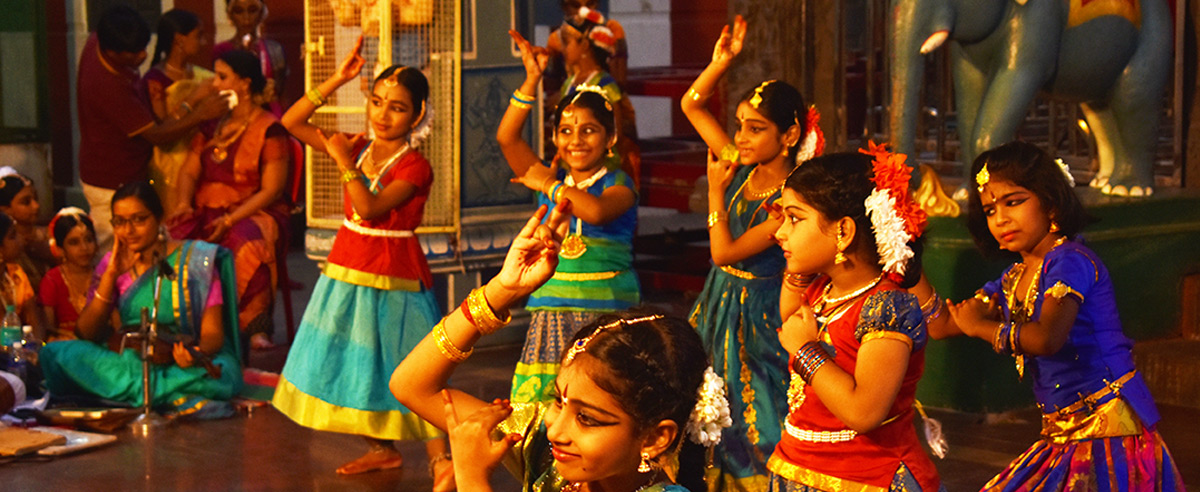Bharatanatyam – India’s Classical Dance Gem

Bharatanatyam, a classical dance form originating from the southern state of Tamil Nadu, is a meticulously structured and stylized art with a deep historical and cultural heritage. It is a mesmerizing dance that harmoniously melds grace, rhythm, storytelling, and spirituality.
History of Bharatanatyam:
Bharatanatyam’s origins can be traced back to the temples of Tamil Nadu, where it was originally known as “Dasi Attam” or “Sadir.” It was performed by Devadasis, who were female temple dancers dedicated to serving deities through their dance and music. The Devadasis played a significant role in the rituals and religious ceremonies of the temples.
In the temples, Bharatanatyam was performed as a form of religious expression, storytelling, and devotion. It was used to convey stories from Hindu mythology, epics like the Ramayana and Mahabharata, and other sacred narratives. The dance was considered a divine offering and a way to connect with the gods.
During the British colonial period in India, Devadasis faced significant social and cultural changes. The British administration and Christian missionaries viewed the Devadasi tradition with suspicion, leading to the suppression of temple dance practices. As a result, the dance was pushed into obscurity and underwent a transformation.
The post-independence period in India saw a resurgence of interest in Bharatanatyam. It was recognized as one of the classical dance forms of India and gained institutional support and patronage. Dancers and gurus continued to innovate and adapt the art form while preserving its core traditions.
Elements of Bharatanatyam:
Nritta : It consists of intricate and rhythmic movements of the body, particularly the legs and feet. Nritta focuses on the dancer’s physical technique, showcasing their mastery of adavus (basic dance units), footwork, and complex patterns.
Nritya: Nritya is the expressive aspect of Bharatanatyam. It involves storytelling through facial expressions, hand gestures (mudras), and body movements. The dancer conveys emotions, moods, and the meaning of the song or story through Nritya. Abhinaya, the art of expression, is a crucial part of Nritya.
Mudras: Mudras are intricate hand gestures that have specific symbolic meanings. Bharatanatyam uses over fifty mudras to convey a wide range of emotions, objects, and ideas. These gestures are essential for storytelling and are mastered through rigorous training.
Abhinaya: Abhinaya is the art of emotional expression in Bharatanatyam. It involves using the entire body, especially the eyes, face, and hands, to convey the lyrics and sentiments of a song or story. Abhinaya requires a deep understanding of the content and the ability to connect with the audience emotionally.
Rasa : In Bharatanatyam, “rasa” encapsulates the emotional essence that the dancer communicates to the audience. This classical dance form aspires to awaken distinct rasas, including love (shringara), valor (veera), compassion (karuna), and more, crafting a profound emotional resonance with the viewers.
Bhava : Complementing rasa is “bhava,” which signifies the emotional mood or state of mind portrayed by the dancer throughout the performance. Bhava works in tandem with rasa, enabling the conveyance of nuanced emotions linked to the character or theme being enacted.
Natya: Natya encompasses the dramatic aspect of Bharatanatyam. It includes the use of dramatic elements and expressions in storytelling, often involving characters, dialogues, and narratives. The dancer may enact various roles and characters within a performance.
Costume and Makeup: Traditional Bharatanatyam costumes include colorful silk saris for female dancers and dhotis for male dancers. Jewelry, such as earrings, necklaces, and anklets with bells, complements the attire. Elaborate makeup, including bold eye makeup and distinctive facial expressions, is used to enhance the visibility of expressions on stage.
Music and Instruments: Bharatanatyam is often accompanied by classical South Indian music, including vocalists singing Carnatic music compositions. Instruments like the mridangam (percussion), violin, flute, and veena are commonly used. The music sets the rhythm and melody for the dance.
Stage and Lighting: The stage for Bharatanatyam performances is usually well-lit to accentuate the dancer’s expressions and movements. Special attention is given to the use of dramatic lighting to create a visually appealing and evocative atmosphere.
Choreography: Bharatanatyam choreography involves the arrangement and sequence of movements, compositions, and storytelling elements in a dance piece. Choreographers carefully structure the performance to create a harmonious and aesthetically pleasing presentation.
Global Appeal:
Bharatanatyam has gained international recognition and appreciation. Dancers and dance schools in various countries offer training in Bharatanatyam, and it is often performed at cultural events and festivals worldwide, contributing to the global dissemination of Indian culture. Dancers from diverse cultural backgrounds are increasingly taking up Bharatanatyam and collaborating with traditional Indian practitioners. This fusion of different dance styles and influences creates innovative and appealing performances.
Epilogue:
Bharatanatyam, a sublime dance form, weaves a rich tapestry of tradition, spirituality, and artistry. Its intricate hand gestures, expressive movements, and storytelling prowess mesmerize audiences globally. From its sacred origins in South Indian temples to its resurgence in the face of colonial challenges, Bharatanatyam has transcended borders and resonated with diverse cultures. This classical dance stands as a testament to the enduring power of art to unite, inspire, and evoke profound emotions.
